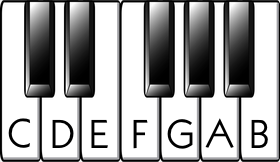Question: What are the two pitches in music called?
Albert’s reply: There aren’t just two pitches in music, there are as many pitches as there are colors.
Yet pitches aren’t the same as notes. A given note can be tuned to a different pitch. This means that it can be adjusted slightly higher or lower, but not enough to be a different note altogether. (It’s actually somewhat more complex than that, but I don’t want to confuse beginners.)
Fortunately, in virtually all of Western music, we can reduce all the possible notes to only 12. This is the number of keys on a piano within an octave:

However, we can reduce these still further to only the white keys.
The white keys play the naturals: A, B, C, D, E, F and G:

These are the primary notes in Western music, meaning that others (those with sharps or flats) are derived from them.
To help you understand the difference between notes and pitches, think of a rainbow. Coincidentally, just like the seven naturals in music, a rainbow has seven distinct colors: red, orange, yellow, green, blue, indigo and violet.
Yet a rainbow actually has an infinite number of colors since they comprise the entire color spectrum. Whether the explanation is cultural or biological or both, we just happen to “see” only seven colors.
If a color is slightly off “true” green but not close enough to blue, we still see it as green in a rainbow.
Musical pitches are like this as well, in that they can be tuned slightly higher or lower and still retain their identity. An orchestra uses the A above middle C as a reference and typically tunes it to a frequency of 440 Hertz, meaning that the violin string used to tune the orchestra is set to vibrate 440 times per second. (Pianos are also usually tuned to A 440… otherwise they’d be out of tune with the orchestra!)
Yet some orchestras, such as the Vienna Philharmonic, tune the A slightly higher to 443 Hz for a brighter sound. All the other notes are tuned around this A, so the actual pitch (the number of vibrations per second) changes accordingly.
It’s like saying the Vienna Philharmonic uses a slightly “more indigo indigo” as a reference. It’s still “indigo enough” to be considered indigo.
Historically, the pitch of A actually ran the gamut from 309 to over 480 Hz, according to definitive research I’ve seen. That’s like picking any color of the rainbow and calling it indigo!
Start Your NEW Piano Journey
Sign up below and each week for the next year, I'll send you a conservatory-quality 3- to 5-minute lesson sharing exclusive playing and practice techniques used by concert artists worldwide.
Each lesson has been carefully crafted to meet the needs of players ranging from beginners to the late intermediate level.
As a very special bonus, you'll also receive invitations to join our exclusive live Keys to Mastery™ monthly masterclasses.
We will never sell your information, for any reason.

